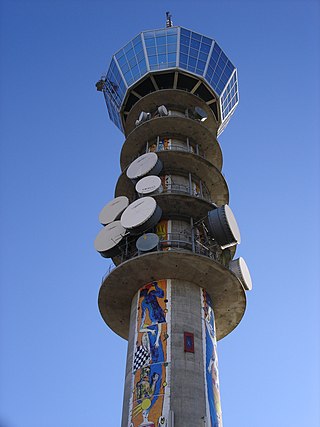Related Research Articles

A wireless network is a computer network that uses wireless data connections between network nodes. Wireless networking allows homes, telecommunications networks and business installations to avoid the costly process of introducing cables into a building, or as a connection between various equipment locations. Admin telecommunications networks are generally implemented and administered using radio communication. This implementation takes place at the physical level (layer) of the OSI model network structure.

Electromagnetic compatibility (EMC) is the ability of electrical equipment and systems to function acceptably in their electromagnetic environment, by limiting the unintentional generation, propagation and reception of electromagnetic energy which may cause unwanted effects such as electromagnetic interference (EMI) or even physical damage to operational equipment. The goal of EMC is the correct operation of different equipment in a common electromagnetic environment. It is also the name given to the associated branch of electrical engineering.

In telecommunication, especially radio communication, spread spectrum are techniques by which a signal generated with a particular bandwidth is deliberately spread in the frequency domain over a wider frequency band. Spread-spectrum techniques are used for the establishment of secure communications, increasing resistance to natural interference, noise, and jamming, to prevent detection, to limit power flux density, and to enable multiple-access communications.

Frequency-hopping spread spectrum (FHSS) is a method of transmitting radio signals by rapidly changing the carrier frequency among many frequencies occupying a large spectral band. The changes are controlled by a code known to both transmitter and receiver. FHSS is used to avoid interference, to prevent eavesdropping, and to enable code-division multiple access (CDMA) communications.

Electromagnetic warfare or electronic warfare (EW) is warfare involving the use of the electromagnetic spectrum or directed energy to control the spectrum, attack an enemy, or impede enemy operations. The purpose of electromagnetic warfare is to deny the opponent the advantage of—and ensure friendly unimpeded access to—the EM spectrum. Electromagnetic warfare can be applied from air, sea, land, or space by crewed and uncrewed systems, and can target communication, radar, or other military and civilian assets.

A communication channel refers either to a physical transmission medium such as a wire, or to a logical connection over a multiplexed medium such as a radio channel in telecommunications and computer networking. A channel is used for information transfer of, for example, a digital bit stream, from one or several senders to one or several receivers. A channel has a certain capacity for transmitting information, often measured by its bandwidth in Hz or its data rate in bits per second.

Radio broadcasting is the broadcasting of audio (sound), sometimes with related metadata, by radio waves to radio receivers belonging to a public audience. In terrestrial radio broadcasting the radio waves are broadcast by a land-based radio station, while in satellite radio the radio waves are broadcast by a satellite in Earth orbit. To receive the content the listener must have a broadcast radio receiver (radio). Stations are often affiliated with a radio network that provides content in a common radio format, either in broadcast syndication or simulcast, or both. The encoding of a radio broadcast depends on whether it uses an analog or digital signal. Analog radio broadcasts use one of two types of radio wave modulation: amplitude modulation for AM radio, or frequency modulation for FM radio. Newer, digital radio stations transmit in several different digital audio standards, such as DAB, HD radio, or DRM.

Wireless communication is the transfer of information (telecommunication) between two or more points without the use of an electrical conductor, optical fiber or other continuous guided medium for the transfer. The most common wireless technologies use radio waves. With radio waves, intended distances can be short, such as a few meters for Bluetooth, or as far as millions of kilometers for deep-space radio communications. It encompasses various types of fixed, mobile, and portable applications, including two-way radios, cellular telephones, personal digital assistants (PDAs), and wireless networking. Other examples of applications of radio wireless technology include GPS units, garage door openers, wireless computer mouse, keyboards and headsets, headphones, radio receivers, satellite television, broadcast television and cordless telephones. Somewhat less common methods of achieving wireless communications involve other electromagnetic phenomena, such as light and magnetic or electric fields, or the use of sound.

The Goldstone Deep Space Communications Complex (GDSCC), commonly called the Goldstone Observatory, is a satellite ground station located in Fort Irwin in the U.S. state of California. Operated by NASA's Jet Propulsion Laboratory (JPL), its main purpose is to track and communicate with interplanetary space missions. It is named after Goldstone, California, a nearby gold-mining ghost town.
Broadband over power lines (BPL) is a method of power-line communication (PLC) that allows relatively high-speed digital data transmission over public electric power distribution wiring. BPL uses higher frequencies, a wider frequency range, and different technologies compared to other forms of power-line communications to provide high-rate communication over longer distances. BPL uses frequencies that are part of the radio spectrum allocated to over-the-air communication services; therefore, the prevention of interference to, and from, these services is a very important factor in designing BPL systems.
A cognitive radio (CR) is a radio that can be programmed and configured dynamically to use the best channels in its vicinity to avoid user interference and congestion. Such a radio automatically detects available channels, then accordingly changes its transmission or reception parameters to allow more concurrent wireless communications in a given band at one location. This process is a form of dynamic spectrum management.

Electromagnetic interference (EMI), also called radio-frequency interference (RFI) when in the radio frequency spectrum, is a disturbance generated by an external source that affects an electrical circuit by electromagnetic induction, electrostatic coupling, or conduction. The disturbance may degrade the performance of the circuit or even stop it from functioning. In the case of a data path, these effects can range from an increase in error rate to a total loss of the data. Both human-made and natural sources generate changing electrical currents and voltages that can cause EMI: ignition systems, cellular network of mobile phones, lightning, solar flares, and auroras. EMI frequently affects AM radios. It can also affect mobile phones, FM radios, and televisions, as well as observations for radio astronomy and atmospheric science.

Military communications or military signals involve all aspects of communications, or conveyance of information, by armed forces. Examples from Jane's Military Communications include text, audio, facsimile, tactical ground-based communications, naval signalling, terrestrial microwave, tropospheric scatter, satellite communications systems and equipment, surveillance and signal analysis, security, direction finding and jamming. The most urgent purposes are to communicate information to commanders and orders from them.
Link adaptation, comprising adaptive coding and modulation (ACM) and others, is a term used in wireless communications to denote the matching of the modulation, coding and other signal and protocol parameters to the conditions on the radio link. For example, WiMAX uses a rate adaptation algorithm that adapts the modulation and coding scheme (MCS) according to the quality of the radio channel, and thus the bit rate and robustness of data transmission. The process of link adaptation is a dynamic one and the signal and protocol parameters change as the radio link conditions change—for example in High-Speed Downlink Packet Access (HSDPA) in Universal Mobile Telecommunications System (UMTS) this can take place every 2 ms.

Antenna diversity, also known as space diversity or spatial diversity, is any one of several wireless diversity schemes that uses two or more antennas to improve the quality and reliability of a wireless link. Often, especially in urban and indoor environments, there is no clear line-of-sight (LOS) between transmitter and receiver. Instead the signal is reflected along multiple paths before finally being received. Each of these bounces can introduce phase shifts, time delays, attenuations, and distortions that can destructively interfere with one another at the aperture of the receiving antenna.

In radio reception, radio noise is unwanted random radio frequency electrical signals, fluctuating voltages, always present in a radio receiver in addition to the desired radio signal. Radio noise near in frequency to the radio signal being received interferes with it in the receiver's circuits. Radio noise is a combination of natural electromagnetic atmospheric noise created by electrical processes in the atmosphere like lightning, manmade radio frequency interference (RFI) from other electrical devices picked up by the receiver's antenna, and thermal noise present in the receiver input circuits, caused by the random thermal motion of molecules.
3G MIMO describes MIMO techniques which have been considered as 3G standard techniques.

Polarization-division multiplexing (PDM) is a physical layer method for multiplexing signals carried on electromagnetic waves, allowing two channels of information to be transmitted on the same carrier frequency by using waves of two orthogonal polarization states. It is used in microwave links such as satellite television downlinks to double the bandwidth by using two orthogonally polarized feed antennas in satellite dishes. It is also used in fiber optic communication by transmitting separate left and right circularly polarized light beams through the same optical fiber.
One way of outlining the subject of radio science is listing the topics associated with it by authoritative bodies.

Electromagnetic radio frequency (RF) convergence is a signal-processing paradigm that is utilized when several RF systems have to share a finite amount of resources among each other. RF convergence indicates the ideal operating point for the entire network of RF systems sharing resources such that the systems can efficiently share resources in a manner that's mutually beneficial. With communications spectral congestion recently becoming an increasingly important issue for the telecommunications sector, researchers have begun studying methods of achieving RF convergence for cooperative spectrum sharing between remote sensing systems and communications systems. Consequentially, RF convergence is commonly referred to as the operating point of a remote sensing and communications network at which spectral resources are jointly shared by all nodes of the network in a mutually beneficial manner. Remote sensing and communications have conflicting requirements and functionality. Furthermore, spectrum sharing approaches between remote sensing and communications have traditionally been to separate or isolate both systems. This results in stove pipe designs that lack back compatibility. Future of hybrid RF systems demand co-existence and cooperation between sensibilities with flexible system design and implementation. Hence, achieving RF convergence can be an incredibly complex and difficult problem to solve. Even for a simple network consisting of one remote sensing and communications system each, there are several independent factors in the time, space, and frequency domains that have to be taken into consideration in order to determine the optimal method to share spectral resources. For a given spectrum-space-time resource manifold, a practical network will incorporate numerous remote sensing modalities and communications systems, making the problem of achieving RF convergence intangible.
References
![]() This article incorporates public domain material from Federal Standard 1037C. General Services Administration. Archived from the original on 2022-01-22.
This article incorporates public domain material from Federal Standard 1037C. General Services Administration. Archived from the original on 2022-01-22.